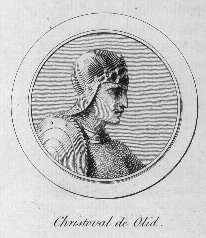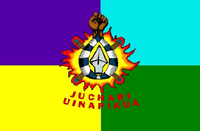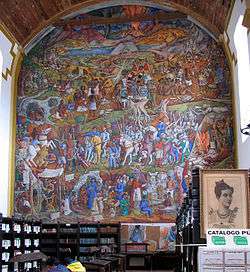Purépecha
The Purépecha or Tarascans (endonym P'urhépecha [pʰuˈɽepet͡ʃa]) are a group of indigenous people centered in the northwestern region of Michoacán, Mexico, mainly in the area of the cities of Cherán and Pátzcuaro.
Purépecha children at the 2015 Muestra de Indumentaria Tradicional de Ceremonias y Danzas de Michoacán | |
| Total population | |
|---|---|
| 141,177[1] (2015 census) | |
| Regions with significant populations | |
| Michoacán, México | |
| Languages | |
| Purépecha, Mexican Spanish | |
| Religion | |
| Roman Catholicism Purépecha religion |
They are also known by the pejorative "Tarascan", an exonym, applied by outsiders and not one they use for themselves.
The Purépecha occupied most of Michoacán but also some of the lower valleys of both Guanajuato and Jalisco. Celaya, Acámbaro, Cerano, and Yurirapúndaro. Now, the Purépecha live mostly in the highlands of central Michoacán, around Lakes Pátzcuaro and Cuitzeo.
History
Prehispanic history
It was one of the major empires of the Pre-Columbian era. The capital city was Tzintzuntzan. Purépecha architecture is noted for step pyramids in the shape of the letter "T". Pre-Columbian Purépecha artisans made feather mosaics that extensively used hummingbird feathers, which were highly regarded as luxury goods throughout the region.
The Purépecha empire was never conquered by the Aztec Empire, in fact there is no record of the Aztecs ever defeating them in battle. This was most likely due to the presence of metal ores within their empire, and their knowledge of metallurgy, which was far superior to that of the Aztecs; such skills have persisted in their descendants and are still widely regarded today, particularly their coppersmithing. Even though they were enemies with the Aztecs, the Aztecs still traded with them, mainly for metal tools and weapons.
Spanish era 1525-1821

After hearing of the Spanish conquest of the Aztec Empire and having the native population much diminished by an epidemic of smallpox, the cazonci Tangaxuan II pledged his allegiance as a vassal of the King of Spain without a fight in 1525. It is believed that the Spanish conquistador Cristóbal de Olid, upon arriving in the Tarascan State, now in present-day Michoacán, explored some parts of Guanajuato in the early 1520s. A legend relates of a 16- or 17-year-old Purépecha, Princess Eréndira, who led her people into a fierce war against the Spanish. Using stolen Spanish horses, her people learned to ride into battle. In 1529 to 1530, the Spanish forces entered Michoacán and some parts of Guanajuato with an army of 500 Spanish soldiers and more than 10,000 Indian warriors.

Then, in 1530, the president of the Real Audiencia, Nuño de Guzmán, a conquistador notorious for his ruthlessness and brutality towards the natives, plundered the region and executed Tangaxuan II, destroying the Purépecha State and provoking a chaotic situation and widespread violence. In 1533, the Crown sent an experienced Oidor (Judge of the Audiencia) and later bishop, Don Vasco de Quiroga, who established a lasting colonial rule. The lands of the Purépecha was subjected to serious deforestation during the Spanish Colonial period. [2]
Post-independence history
Cárdenas era
.tif.jpg)
Following the Mexican Revolution (1910-1920) Michoacan experienced political unrest. When former revolutionary general Lázaro Cárdenas, originally from a small town in Michoacan, was appointed governor of his state, he began an ambitious program of reform and economic development, which he continued when he became president of Mexico (1934-40). For him, the indigenous heritage of Michoacan was foundational for the construction of Mexico's post-revolutionary identity. Although the Aztecs loomed large in Mexican history and the construction of identity, Cárdenas saw the Purépecha as "purer" source. The Purépecha had never been conquered by the Aztecs, but in the era of the Spanish conquest, the resistance of the Purépecha was a point of regional pride. In particular, Cárdenas promoted the story of Princess Eréndira who is said to have fought against the Spanish.[3] He named the house he built in Pátzcuaro "La Quinta Eréndira" and commissioned muralists to depict Purépecha history in his residence and elsewhere.[4] Purépecha traditions of folkloric performance became a source of indigenista pride.[5]

Religion
Many traditions live on, including the Jimbani Uexurhina (New Year), which is celebrated on February 2. It has both traditional indigenous and Catholic elements. The community lights a fire, called the chijpiri jimbani or "new fire," as part of a ceremony that honors the four elements. Mass is also celebrated in the Purhépecha language.
Culture
The Purépecha are mainly subsistence farmers. They are also known for their skill in weaving and pottery. Many live in wooden cabins within compounds surrounded by dry-stone walls. However, many of these structures are being replaced with homes made out of brick and concrete. One distinctive practice of the Purépecha include the baptization of newborns after forty days of separate rest for the mother and child. The infant is then swaddled for six weeks and kept in physical contact with the mother or a close female relative.[8]
Language

The Purépecha language is spoken by nearly 200,000 people in Michoacán. Since Mexico's 2000 indigenous language law, indigenous languages like Purépecha were granted official status equal with Spanish in the areas in which they are spoken. Recently, educational instruction in Purépecha has been introduced in the local school systems. Additionally, many Purépecha communities offer classes and lessons in the language.
Brief Sociological Context
The Purépecha people in Michoacán have low socioeconomic mobility. It is not common for individuals to go to school past the sixth grade roughly and there is very little accessible healthcare services. The Purépecha folk rely heavily on fishing for their substance as well as tourism in the area. There remains little research about the Purépecha people so thus, there are little available resources to provide the people with. Indigenous peoples in Mexico are part of the lowest socioeconomic classes and unfortunately, the Purépecha people are challenged with a lot of the systemic oppressions that face indigenous peoples overall.
See also
- Pirekua
- Pelota purépecha
- Purépecha deities
- Purépecha Empire
- Purépecha language
- Tarascan state
References
- "Purépecha". 26 December 2016.
- "Research paper" (PDF). www.unesco.org.uy.
-
- Ramírez Barreto, Ana Cristina, "'Eréndira a caballo': Acoplamiento de cuerpos e historias en un relato de conquista y resistencia". e-misférica: Sexualities and Politics in the Americas, 2 no. 2 (2005)1-19.
- Jolly, Jennifer. Creating Pátzcuaro, Creating Mexico: Art, Tourism, and Nation Building Under Lázaro Cárdenas. Austin: University of Texas Press 2018
- Hellier-Tinoco, Ruth. Embodying Mexico: Tourism, Nationalism, and Performance. New York: Oxford University Press 2011.
- Anderson, Warren. "P’urépecha migration into the US Rural Midwest: History and current trends." Indigenous Mexican Migrants in the United States, edited by Jonathan Fox and Gaspar Rivera-Salgado, La Jolla: University of California, San Diego, Center for Comparative Immigration Studies/Center for US-Mexican Studies (2004).
- Marr, Paul, and Christopher Sutton. "Demographic changes in the Purepecha region of Michoacan, Mexico: 1970-2000." Journal of Latin American Geography (2004): 52-66.
- Winston, Robert, ed. (2004). Human: The Definitive Visual Guide. New York: Dorling Kindersley. p. 364. ISBN 0-7566-0520-2.
Further reading
- Anderson, Warren. "P’urépecha migration into the US Rural Midwest: History and current trends." Indigenous Mexican Migrants in the United States, edited by Jonathan Fox and Gaspar Rivera-Salgado, La Jolla: University of California, San Diego, Center for Comparative Immigration Studies/Center for US-Mexican Studies (2004).
- Bellamy, K. R. "On the external relations of Purepecha: an investigation into classification, contact and patterns of word formation." Diss. 2018.
- Boyd, Maurice. Tarascan myths & legends: a rich and imaginative history of the Tarascans. No. 4. Texas Christian University Press, 1969.
- Boyd, Maurice. Eight Tarascan Legends. No. 3. University of Florida, 1958.
- Brand, Donald D. "An Historical Sketch of Geography and Anthropology in the Tarascan Region: Part I." New Mexico Anthropologist 6.2 (1943): 37-108.
- Bush, Jason W. "Architectural patterning in the Purepecha heartland: An intrasite settlement study at the urban center of Sacapu Angamuco, Michoacán, México." Diss. Colorado State University, 2012.
- Carot, Patricia, and Marie-Areti Hers. "Epic of the Toltec Chichimec and the Purepecha in the Ancient Southwest." Archaeology without Borders. Contact, Commerce, and Change in the US Southwest and Northwestern Mexico, Boulder, University Press of Colorado (2008): 301–334.
- Chamoreau, Claudine. "Dialectology, typology, diachrony, and contact linguistics: A multi-layered perspective in Purepecha." STUF-Language Typology and Universals Sprachtypologie und Universalienforschung 65.1 (2012): 6-25.
- Cohen, Anna S., and Christopher Fisher. "The Tarascan (Purépecha) Empire." The Oxford Handbook of the Aztecs.
- Godinez, Isaura. "Migration and Health Outcomes in Purepecha Sending Communities." PhD Diss. The University of North Carolina at Chapel Hill, 2016.
- Haskell, David L. "From Tribute to Communal Sovereignty: The Tarascan and Caxcan Territories in Transition." The Canadian Journal of Native Studies 35.2 (2015): 265.
- Haskell, David Louis. "History and the construction of hierarchy and ethnicity in the prehispanic Tarascan state: a syntagmatic analysis of the Relación de Michoacán." Diss. University of Florida, 2003.
- Hellier-Tinoco, Ruth. Embodying Mexico: Tourism, Nationalism, and Performance. New York: Oxford University Press 2011.
- Jolly, Jennifer. Creating Pátzcuaro, Creating Mexico: Art, Tourism, and Nation Building Under Lázaro Cárdenas. Austin: University of Texas Press 2018. ISBN 978-1477-314203
- Kemper, Robert V., and Julie Adkins. "From the" Modern Tarascan Area" to the" Patria Purépecha: Changing Concepts of Ethnic and Regional Identity."." (2006).
- Krippner-Martínez, James. "The politics of conquest: An interpretation of the Relación de Michoacán." The Americas 47.2 (1990): 177–197.
- Malmstrom, Vincent H. "Geographical origins of the Tarascans." Geographical Review (1995): 31–40.
- Marr, Paul, and Christopher Sutton. "Demographic changes in the Purepecha region of Michoacan, Mexico: 1970-2000." Journal of Latin American Geography (2004): 52–66.
- Marr, Paul, and Christopher Sutton. "Impacts of Transportation Changes on the Woodworking Industry of Mexico's Purépecha Region." Geographical Review 94.4 (2004): 440–461.
- Pollard, Helen Perlstein. "The construction of ideology in the emergence of the prehispanic Tarascan state." Ancient Mesoamerica 2.2 (1991): 167–179.
- Pollard, Helen Perlstein. "A model of the emergence of the Tarascan State." Ancient Mesoamerica 19.2 (2008): 217–230.
- Ragone, Agnes, and Paul Marr. "Language maintenance in the Meseta Purépecha region of Michoacán, Mexico." Anthropological linguistics (2006): 109–131.
- Ramírez Barreto, Ana Cristina, "'Eréndira a caballo': Acoplamamiento de Cuerpos e historias en un relato de conquista y resistencia."e-misférica: Performance and Politics in the Americas, 2 no. 2 (2005)1-19.
- Roskamp, Hans. "Tarascan (P'urhépecha) Empire." The Encyclopedia of Empire (2016): 1–3.
- Roth-Seneff, Andrew, Robert V. Kemper, and Julie Adkins, eds. From Tribute to Communal Sovereignty: The Tarascan and Caxcan Territories in Transition. University of Arizona Press, 2016.
- Silverstein, Jay E. "A Study of the Late Postclassic Aztec-Tarascan Frontier in Northern Guerrero, Mexico: The Oztuma-Cutzamala Project." (2000).
- Thurtell, Joel, and Emily Klancher Merchant. "Gender-Differentiated Tarascan Surnames in Michoacán." Journal of Interdisciplinary History 48.4 (2018): 465–483.
External links
- P'urhépecha WEB Page and Community
- P'urhépecha Literature
- Beautiful P'urhépecha women
- P'urhépecha mother with her son
- Chap. 9: The Twilight of the Gods: The Arrival of the Purépecha (Cycles of the Sun, Mysteries of the Moon; includes area map)
